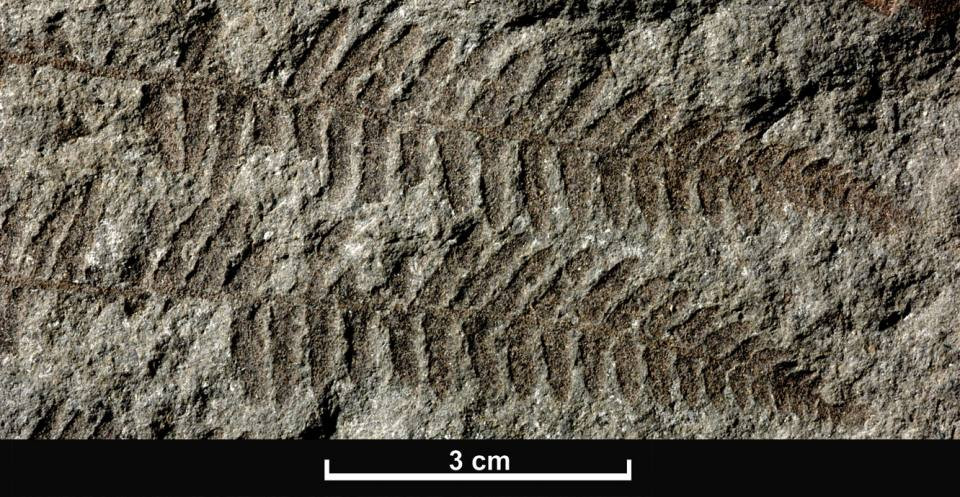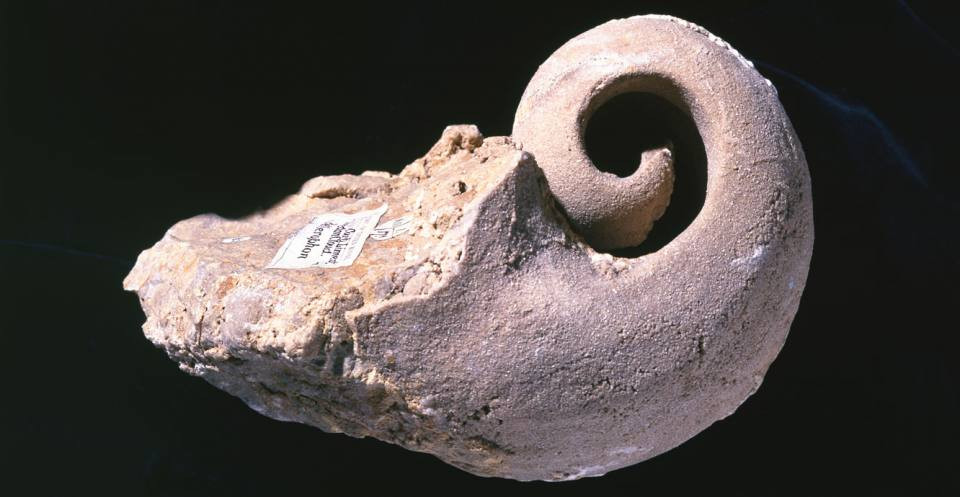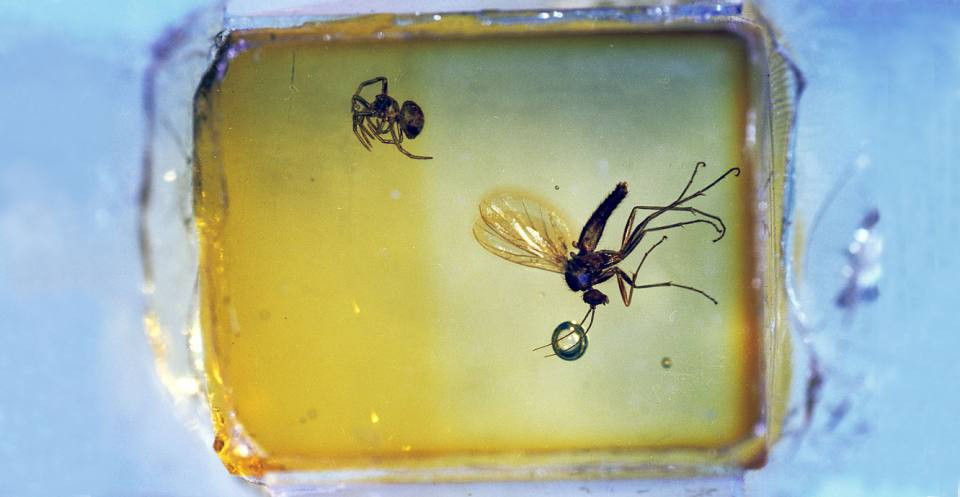What Kind Of Rock Are Fossils Found In? Fossils are primarily discovered in sedimentary rocks, offering invaluable insights into Earth’s history and the evolution of life, and at rockscapes.net, we’re passionate about connecting you with the world of natural stone and the stories it holds. Explore rock formations and fossilized treasures, uncovering the perfect stone to enhance your landscape.
1. Why Sedimentary Rocks Are Fossil Hotspots
Fossils are overwhelmingly found in sedimentary rocks. These rocks form from accumulated sediments like sand, mud, and organic matter, creating the ideal environment for preservation. Sedimentary rocks provide geologists and landscape enthusiasts alike with a peek into prehistoric life.
Sedimentary rocks offer a unique window into the past. These rocks originate from layers of sediment deposited over time, often in aquatic environments such as ancient seas, lakes, and rivers. The gradual accumulation of these sediments creates a protective casing, enabling the fossilization process.
1.1 The Burial Process
Rapid burial is crucial for fossil formation. When an organism dies, its remains must be quickly covered by sediment to protect them from scavengers, weathering, and decomposition.
1.2 Permineralization
A common fossilization process in sedimentary rocks is permineralization. According to research from the Paleontological Society in June 2024, minerals dissolved in groundwater fill the pores of the organism’s remains, hardening over time and turning the organic material into stone.
1.3 Types of Sedimentary Rocks
Common sedimentary rocks with fossils are sandstone, shale, and limestone. Each offers distinct preservation qualities.
| Sedimentary Rock | Description | Common Fossils |
|---|---|---|
| Sandstone | Formed from cemented sand grains; porous and permeable. | Plant fossils, footprints, burrows |
| Shale | Made of compacted mud and clay; fine-grained and layered. | Fish, insects, leaves |
| Limestone | Composed mainly of calcium carbonate; often formed from marine organisms’ shells and skeletons. | Shells, corals, marine invertebrates |
2. The Fossilization Process: A Step-by-Step Guide
How do fossils end up embedded in rock? The fossilization process is a series of specific events that turn organic remains into stone. Understanding this process can help you appreciate the incredible journey each fossil has undertaken.
2.1 Death and Initial Decay
The process begins when an organism dies. Soft tissues decay rapidly, leaving behind hard parts like bones, shells, or teeth.
2.2 Rapid Burial
Quick burial by sediment is essential to protect the remains from destruction by scavengers, weather, and decomposition.
2.3 Mineral Replacement
Over time, minerals in groundwater seep into the remains, replacing the organic material. This process, known as permineralization, turns the remains into stone.
2.4 Compaction and Cementation
The weight of overlying sediments compacts the layers, and minerals dissolved in water cement the particles together, forming solid rock.
2.5 Erosion and Exposure
Geological processes like erosion can expose the fossil-bearing rock layers, allowing paleontologists and enthusiasts to discover these ancient treasures.
3. Types of Fossilization: Beyond Petrification
Petrification is just one way fossils form. Several methods preserve ancient life, each resulting in different types of fossils.
3.1 Petrification
Petrification occurs when minerals replace the original organic material, turning it into stone. The most common form is permineralization, where mineral-rich fluids fill the pores within the remains.
3.2 Compression
Compression happens when the remains are flattened by the weight of overlying sediments, leaving a dark imprint. Plant fossils are commonly formed this way.
 Plant leaves and ferns are good examples of fossils produced by compression. This image shows Coniopteris is a genus of true fern, or pteropsid, fossil from the Jurassic Period.
Plant leaves and ferns are good examples of fossils produced by compression. This image shows Coniopteris is a genus of true fern, or pteropsid, fossil from the Jurassic Period.
3.3 Molds and Casts
When the original remains dissolve, they leave a void called a mold. If this void is later filled with sediment, it creates a cast, replicating the original form.
 This image is a mould of an ancient snail or slug called Bellerophon, a gastropod. Fossils can form when mould of the interior of the shell is made by water-borne minerals percolating through it, but later the shell material dissolves away.
This image is a mould of an ancient snail or slug called Bellerophon, a gastropod. Fossils can form when mould of the interior of the shell is made by water-borne minerals percolating through it, but later the shell material dissolves away.
3.4 Preserved Remains
The rarest form of fossilization is the preservation of original remains, such as insects trapped in amber or frozen mammoths.
 A fly and spider trapped in amber. Many different animals have been fossilised in amber, from flies and mosquitoes to spiders and snails, and in very rare instances ostracods (
A fly and spider trapped in amber. Many different animals have been fossilised in amber, from flies and mosquitoes to spiders and snails, and in very rare instances ostracods (
4. Common Fossil Types and the Rocks They’re Found In
Different fossils are found in specific types of sedimentary rocks. Knowing where to look can increase your chances of discovering your own prehistoric treasure.
4.1 Marine Fossils in Limestone
Limestone, formed from the shells and skeletons of marine organisms, is rich in marine fossils such as shells, corals, and trilobites.
4.2 Plant Fossils in Shale and Sandstone
Shale and sandstone often contain plant fossils, including leaves, stems, and roots. These rocks formed in environments where plant material was abundant.
4.3 Trace Fossils in Sandstone
Sandstone is an excellent place to find trace fossils like footprints and burrows, providing evidence of ancient animal behavior.
4.4 Insect Fossils in Amber-Bearing Sedimentary Rocks
Rarely, sedimentary rocks may contain amber, fossilized tree resin that can preserve insects and other small organisms in exquisite detail.
5. Where to Find Fossils in the USA
The United States is a treasure trove of fossil sites. Understanding the geology of different regions can guide your fossil-hunting adventures.
5.1 The Badlands of South Dakota
The Badlands National Park in South Dakota is famous for its rich fossil deposits, including mammal fossils from the Oligocene epoch.
5.2 The Green River Formation
Located in Wyoming, Colorado, and Utah, the Green River Formation is known for its well-preserved fish, insect, and plant fossils.
5.3 The La Brea Tar Pits
In Los Angeles, California, the La Brea Tar Pits have preserved fossils of Ice Age mammals, including mammoths, saber-toothed cats, and dire wolves.
5.4 The Petrified Forest National Park
Arizona’s Petrified Forest National Park contains abundant petrified wood, showcasing ancient trees turned to stone. According to a 2023 report by the National Park Service, the park’s unique geological conditions have preserved these fossils for millions of years.
6. Tools and Techniques for Fossil Hunting
Equip yourself with the right tools and techniques to make your fossil hunting expeditions successful and enjoyable.
6.1 Essential Tools
A geological hammer, chisel, safety glasses, and a brush are essential tools for any fossil hunter.
6.2 Research and Preparation
Before heading out, research the local geology and regulations. Obtain necessary permits and familiarize yourself with the types of fossils found in the area.
6.3 Careful Excavation
When you find a fossil, carefully excavate it using your tools. Brush away loose sediment and document the location.
6.4 Documentation and Preservation
Record the location and context of your find. Wrap the fossil in protective material and transport it carefully.
7. The Importance of Fossils in Landscaping
Fossils add unique character to landscaping. Integrating them into your designs brings a touch of history and natural beauty to outdoor spaces.
7.1 Feature Stones
Large fossil-bearing rocks make striking feature stones in gardens and landscapes.
7.2 Decorative Accents
Smaller fossils can be used as decorative accents in rock gardens, pathways, and water features.
7.3 Educational Displays
Create educational displays showcasing fossils in your garden, labeling each specimen with its name and age.
7.4 Rockscapes.net Inspiration
For inspiration and ideas on incorporating fossils into your landscaping, visit rockscapes.net. Discover a wide range of natural stones and expert advice to bring your vision to life.
8. Ethical Fossil Collecting: Preserving the Past
Collecting fossils responsibly ensures that these valuable resources are preserved for future generations.
8.1 Respect Private Property
Always obtain permission before collecting fossils on private land.
8.2 Follow Regulations
Familiarize yourself with local, state, and federal regulations regarding fossil collecting.
8.3 Document Your Finds
Record the location and context of your finds, and consider donating significant specimens to museums or research institutions.
8.4 Minimize Impact
Leave the site as you found it, minimizing disturbance to the surrounding environment.
9. The Role of Fossils in Understanding Earth’s History
Fossils are essential for understanding the history of life on Earth. They provide evidence of evolution, climate change, and geological events.
9.1 Evidence of Evolution
Fossils document the evolution of life over millions of years, showing how organisms have changed and adapted to their environments.
9.2 Climate Change Indicators
Fossil assemblages can indicate past climate conditions, helping scientists understand how climate has changed over time.
9.3 Geological Time Markers
Index fossils are used to date rock layers and correlate geological formations across different regions.
10. FAQ: Your Burning Questions About Fossils Answered
Have more questions about fossils? Here are some common queries to help you on your journey of discovery.
10.1 What exactly is a fossil?
A fossil is the preserved remains or traces of ancient organisms, typically over 10,000 years old.
10.2 How old does something have to be to be considered a fossil?
To be classified as a fossil, remains must generally be at least 10,000 years old.
10.3 Can fossils be found in all types of rock?
No, fossils are primarily found in sedimentary rocks, with rare occurrences in some low-grade metamorphic rocks.
10.4 What are the best places to find fossils in the USA?
Great fossil-hunting locations include the Badlands of South Dakota, the Green River Formation, and the Petrified Forest National Park.
10.5 What tools do I need for fossil hunting?
Essential tools include a geological hammer, chisel, safety glasses, and a brush.
10.6 How can I incorporate fossils into my landscape design?
Use large fossil-bearing rocks as feature stones or smaller fossils as decorative accents in rock gardens and water features.
10.7 What should I do if I find a fossil?
Carefully excavate the fossil, document the location, and wrap it in protective material for transport.
10.8 Is it ethical to collect fossils?
Yes, but always obtain permission before collecting on private land, follow regulations, and minimize your impact on the environment.
10.9 How do fossils help us understand Earth’s history?
Fossils provide evidence of evolution, climate change, and geological events, helping scientists reconstruct the history of life on Earth.
10.10 Where can I learn more about fossils and landscaping?
Visit rockscapes.net for inspiration, ideas, and expert advice on incorporating fossils and natural stones into your landscape designs.
Are you ready to enhance your landscape with the timeless beauty of natural stone and perhaps even a fossil or two? Visit rockscapes.net today to explore our extensive selection of rocks, stones, and landscaping materials. Contact us at +1 (480) 965-9011 or visit our location at 1151 S Forest Ave, Tempe, AZ 85281, United States. Let rockscapes.net help you create a landscape that tells a story millions of years in the making!
